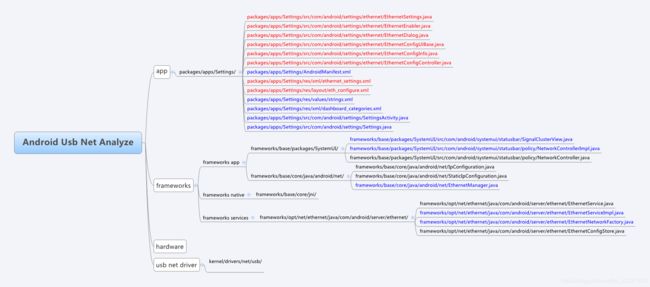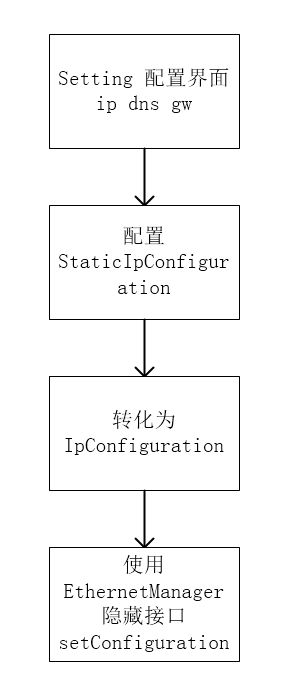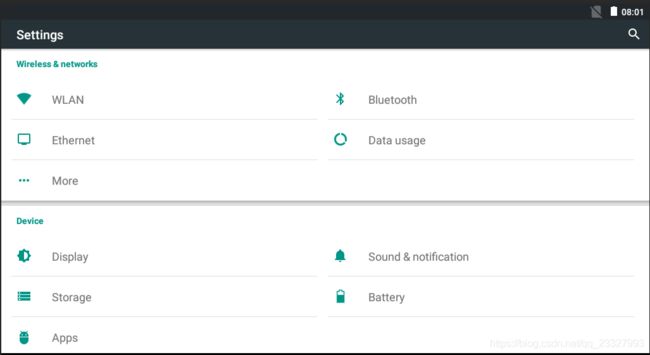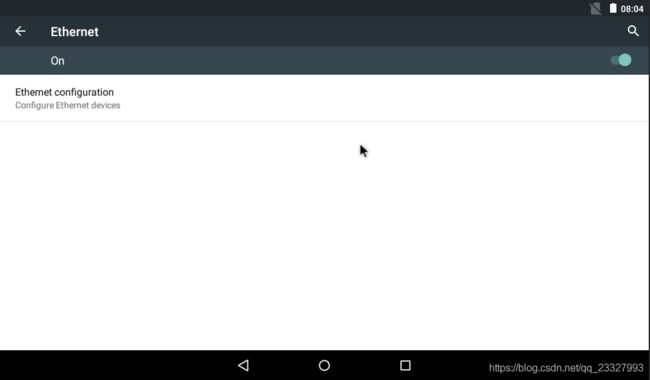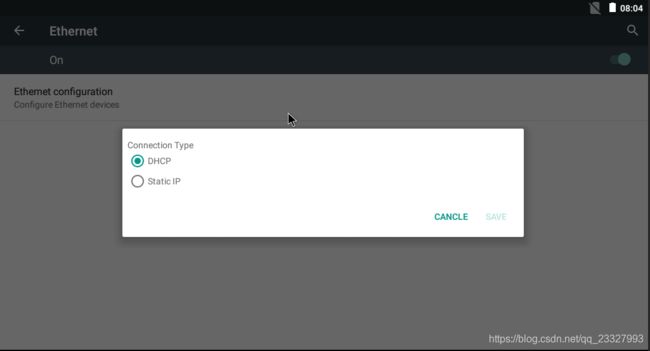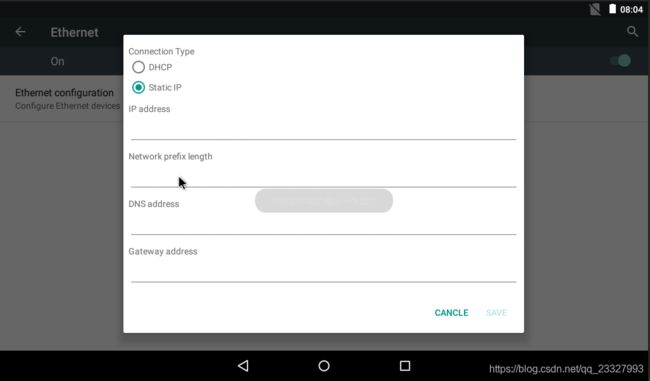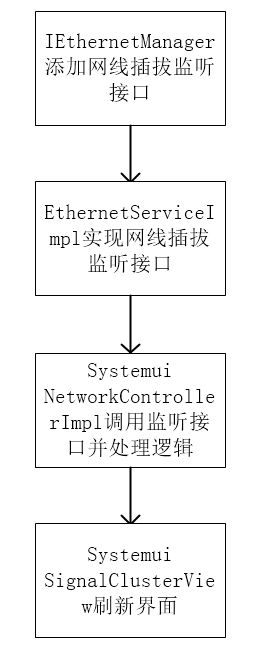Android5.1 Ethernet添加ip配置(Static DHCP)
博主从业经验不多,本次调试Ethernet参考了许多资料,走了很多弯路,现在也还有点问题,先记录下调试心得,文中提到的未解决的问题或写的错误得地方,还望各位看官大佬不吝赐教。
参考:
https://blog.csdn.net/Purple7826/article/details/80608172
https://blog.csdn.net/qq_34705828/article/details/76283929
https://www.jianshu.com/p/3d95347633a3
本文基于qcom msm8909平台,先以思维导图的形式展示下调试Ethernet修改或添加的文件。
然后在描述下settings app层基本实现思路:
实现步骤:
1:settings 部分
添加一级子菜单:packages/apps/Settings/res/xml/dashboard_categories.xml
修改string :packages/apps/Settings/res/values/strings.xml
Ethernet
Configure Ethernet device
Ethernet
Ethernet Devices:
Connection Type
DHCP
Static IP
DNS address
Gateway address
IP address
Ethernet
Turn on Ethernet
Ethernet configuration
Configure Ethernet devices
Netmask
Turn off Ethernet
Turn on Ethernet
Failed to set: Please enter the valid characters 0~255
can\'t be empty
Network prefix length
Cancle
Save Setting主类添加:packages/apps/Settings/src/com/android/settings/SettingsActivity.java
import com.android.settings.ethernet.EthernetSettings;
R.id.ethernet_settings,
EthernetSettings.class.getName(),
添加空类:packages/apps/Settings/src/com/android/settings/Settings.java
public static class EthernetSettingsActivity extends SettingsActivity { /* empty */ }AndroidMainfest添加:packages/apps/Settings/AndroidManifest.xml
增加Ethernet主界面布局:packages/apps/Settings/res/xml/ethernet_settings.xml
添加Ethernet主类:packages/apps/Settings/src/com/android/settings/ethernet/EthernetSettings.java
至此:setting里面的界面布局等全部完成,逻辑处理等详情或代码就不具体详叙了。
效果图如下:
接下来分析下调用完setConfiguration()之后的流程,惯例,先上一张图。
当我们调用setConfiguration()之后,肯定在想这个方法里面干了些什么,那么我们继续往下走。
先看setConfiguration是通过EthernetManager调用的,我们先找到IEthernetManager.aidl这个通信接口,看看里面的内容。
/*
* Copyright (C) 2014 The Android Open Source Project
*
* Licensed under the Apache License, Version 2.0 (the "License");
* you may not use this file except in compliance with the License.
* You may obtain a copy of the License at
*
* http://www.apache.org/licenses/LICENSE-2.0
*
* Unless required by applicable law or agreed to in writing, software
* distributed under the License is distributed on an "AS IS" BASIS,
* WITHOUT WARRANTIES OR CONDITIONS OF ANY KIND, either express or implied.
* See the License for the specific language governing permissions and
* limitations under the License.
*/
package android.net;
import android.net.IpConfiguration;
import android.net.IEthernetServiceListener;
/**
* Interface that answers queries about, and allows changing
* ethernet configuration.
*/
/** {@hide} */
interface IEthernetManager
{
IpConfiguration getConfiguration();
void setConfiguration(in IpConfiguration config);
boolean isAvailable();
void addListener(in IEthernetServiceListener listener);
void removeListener(in IEthernetServiceListener listener);
}
这里我们看到@hide这个参数,应该就会知道,这个接口被隐藏掉了,应用层的开发是不能调到这个接口的,但我们是在做系统app的调试,没什么关系,正常使用。
但是这里只有方法的定义,实现在哪里呢?简单,实现肯定在EthernetManager.java中,于是找到该文件frameworks/base/core/java/android/net/EthernetManager.java 找到setConfiguration()的实现,
如下:
/**
* Set Ethernet configuration.
*/
public void setConfiguration(IpConfiguration config) {
try {
mService.setConfiguration(config);
} catch (NullPointerException | RemoteException e) {
}
}咋的一看,咦,没干啥啊,实现很简单,原来,通过了aidl的实现,远程通信。
private final IEthernetManager mService;
那既然用了aidl,那接口对应的服务在哪呢,于是首先找到网口服务
frameworks/opt/net/ethernet/java/com/android/server/ethernet/EthernetService.java
看看里面的实现
public final class EthernetService extends SystemService {
private static final String TAG = "EthernetService";
final EthernetServiceImpl mImpl;
public EthernetService(Context context) {
super(context);
mImpl = new EthernetServiceImpl(context);
}
@Override
public void onStart() {
Log.i(TAG, "Registering service " + Context.ETHERNET_SERVICE);
publishBinderService(Context.ETHERNET_SERVICE, mImpl);
}
@Override
public void onBootPhase(int phase) {
if (phase == SystemService.PHASE_SYSTEM_SERVICES_READY) {
mImpl.start();
}
}
}实现很简单,看到构造方法中创建了一个EthernetServiceImpl实例,跟到EthernetServiceImpl.java看看,
frameworks/opt/net/ethernet/java/com/android/server/ethernet/EthernetServiceImpl.java
* @hide
*/
public class EthernetServiceImpl extends IEthernetManager.Stub {如图,后面的没有展示出来,详细了解的请查看源码。
果然,EthernetServiceImpl.java继承了IEthernetManager接口并实现里面的方法。
那么现在就一目了然了。
找到setConfiguration的实现方法
/**
* Set Ethernet configuration
*/
@Override
public void setConfiguration(IpConfiguration config) {
if (!mStarted.get()) {
Log.w(TAG, "System isn't ready enough to change ethernet configuration");
}
enforceChangePermission();
enforceConnectivityInternalPermission();
synchronized (mIpConfiguration) {
mEthernetConfigStore.writeIpAndProxyConfigurations(config);
// TODO: this does not check proxy settings, gateways, etc.
// Fix this by making IpConfiguration a complete representation of static configuration.
if (!config.equals(mIpConfiguration)) {
Log.w(TAG, "!config.equals(mIpConfiguration)");
mIpConfiguration = new IpConfiguration(config);
mTracker.stop();
mTracker.start(mContext, mHandler);
}
}
}如图,方法里调用了frameworks/opt/net/ethernet/java/com/android/server/ethernet/EthernetConfigStore.java
里面的writeIpAndProxyConfigurations(),这样就把配置写入指定的文件了。
可以看看该类的实现,实现也很简单,上个代码就好了。
public class EthernetConfigStore extends IpConfigStore {
private static final String TAG = "EthernetConfigStore";
private static final String ipConfigFile = Environment.getDataDirectory() +
"/misc/ethernet/ipconfig.txt";
public EthernetConfigStore() {
}
public IpConfiguration readIpAndProxyConfigurations() {
SparseArray networks = readIpAndProxyConfigurations(ipConfigFile);
Log.d(TAG, "readIpAndProxyConfigurations networks.size():"+networks.size());
if (networks.size() == 0) {
Log.w(TAG, "No Ethernet configuration found. Using default.");
return new IpConfiguration(IpAssignment.DHCP, ProxySettings.NONE, null, null);
}
if (networks.size() > 1) {
// Currently we only support a single Ethernet interface.
Log.w(TAG, "Multiple Ethernet configurations detected. Only reading first one.");
}
return networks.valueAt(0);
}
public void writeIpAndProxyConfigurations(IpConfiguration config) {
SparseArray networks = new SparseArray();
networks.put(0, config);
writeIpAndProxyConfigurations(ipConfigFile, networks);
}
}
frameworks/opt/net/ethernet/java/com/android/server/ethernet/EthernetNetworkFactory.java
再回到setConfiguration()实现的地方,我们可以看到在实现写配置之后,进行了一个ip配置是否相同的判断,如果有修改了配置,那么就开了一个线程锁,里面对ipConfigure进行配置,并且启动了EthernetNetworkFactory中的start方法。该start方法主要功能就是监控连接。可以看看该方法的实现。
/**
* Begin monitoring connectivity
*/
public synchronized void start(Context context, Handler target) {
// The services we use.
IBinder b = ServiceManager.getService(Context.NETWORKMANAGEMENT_SERVICE);
mNMService = INetworkManagementService.Stub.asInterface(b);
mEthernetManager = (EthernetManager) context.getSystemService(Context.ETHERNET_SERVICE);
// Interface match regex.
mIfaceMatch = context.getResources().getString(
com.android.internal.R.string.config_ethernet_iface_regex);
// Create and register our NetworkFactory.
mFactory = new LocalNetworkFactory(NETWORK_TYPE, context, target.getLooper());
mFactory.setCapabilityFilter(mNetworkCapabilities);
mFactory.setScoreFilter(-1); // this set high when we have an iface
mFactory.register();
mContext = context;
// Start tracking interface change events.
mInterfaceObserver = new InterfaceObserver();
try {
mNMService.registerObserver(mInterfaceObserver);
} catch (RemoteException e) {
Log.e(TAG, "Could not register InterfaceObserver " + e);
}
// If an Ethernet interface is already connected, start tracking that.
// Otherwise, the first Ethernet interface to appear will be tracked.
try {
final String[] ifaces = mNMService.listInterfaces();
for (String iface : ifaces) {
synchronized(this) {
if (maybeTrackInterface(iface)) {
// We have our interface. Track it.
// Note: if the interface already has link (e.g., if we
// crashed and got restarted while it was running),
// we need to fake a link up notification so we start
// configuring it. Since we're already holding the lock,
// any real link up/down notification will only arrive
// after we've done this.
if (mNMService.getInterfaceConfig(iface).hasFlag("running")) {
updateInterfaceState(iface, true);
}
break;
}
}
}
} catch (RemoteException e) {
Log.e(TAG, "Could not get list of interfaces " + e);
}
}
至此,暂时分析到此处了。还有很多地方没分析到,逻辑感觉也不是很清晰,希望大佬们指点。
另外,博主在调试的时候发现,为了应用层更人性化,参照wifi的逻辑和上述提到的参考博客,对Ethernet的网络连接状态,物理接口,网线插拔进行了一些添加,并在systemui中进行一些实时的更新。
这里简单做些说明。
惯例,上图。
先回头看看EthernetManager中的方法里面有个Listener,
/**
* A listener interface to receive notification on changes in Ethernet.
*/
public interface Listener {
/**
* Called when Ethernet port's availability is changed.
* @param isAvailable {@code true} if one or more Ethernet port exists.
*/
public void onAvailabilityChanged(boolean isAvailable);
}这个listener说能检测到一个或者多个网口事件,博主在settings应用层中添加listener后测试确实能够监听到网口事件,但好像不是对网线插拔的,仅仅是对于网口芯片是否接入的检测。
于是,我们得自己添加一个listener来监听网线的接入与拔出。
步骤如下:
1:在网络管理逻辑处理类EthernetNetworkFactory.java中添加一个全局变量用来标志网线的状态
private boolean isEthernetAdded = false;
2:修改网络接口状态监听代码
ps:细心的人可能在刚刚介绍EthernetNetworkFactory.start()中看到了一个叫InterfaceObserver的内部类的使用
// Start tracking interface change events.
mInterfaceObserver = new InterfaceObserver();这里就解释到这个类是跟踪接口更改事件的。
那既然如此我们刚刚定义的变量就放在这里操作。
private class InterfaceObserver extends BaseNetworkObserver {
@Override
public void interfaceLinkStateChanged(String iface, boolean up) {
Log.i(TAG,"interfaceLinkStateChanged---iface:"+iface+"up:"+up);
updateInterfaceState(iface, up);
}
@Override
public void interfaceAdded(String iface) {
Log.i(TAG,"interfaceAdded---iface:"+iface);
maybeTrackInterface(iface);
}
@Override
public void interfaceRemoved(String iface) {
Log.i(TAG,"interfaceRemoved---iface:"+iface);
stopTrackingInterface(iface);
}
}因为我这里只想监听eth0 的 usb net,所以我加了一个监听过滤,修改后如下:
private class InterfaceObserver extends BaseNetworkObserver {
@Override
public void interfaceLinkStateChanged(String iface, boolean up) {
Log.i(TAG,"interfaceLinkStateChanged---iface:"+iface+"up:"+up);
updateInterfaceState(iface, up);
if("eth0".equals(iface)){
Log.i(TAG,"interfaceLinkStateChanged---linked:"+up);
isEthernetAdded = up;
notifyEthernetInjected(isEthernetAdded); // 监听网线插拔
}
}
@Override
public void interfaceAdded(String iface) {
Log.i(TAG,"interfaceAdded---iface:"+iface);
maybeTrackInterface(iface);
if("eth0".equals(iface)){
Log.i(TAG,"interfaceAdded");
isEthernetAdded = true;
notifyEthernetInjected(isEthernetAdded);
}
}
@Override
public void interfaceRemoved(String iface) {
Log.i(TAG,"interfaceRemoved---iface:"+iface);
stopTrackingInterface(iface);
if("eth0".equals(iface)){
Log.i(TAG,"interfaceRemoved");
isEthernetAdded = false;
notifyEthernetInjected(isEthernetAdded);
}
}
}通过改完后的代码可以看出,该类里面重写了三个方法。
interfaceLinkStateChanged:接口状态改变时调用
interfaceAdded:新接口接入时调用
interfaceRemoved:接口移除时调用
看到这里里面好像有个不眼熟的方法notifyEthernetInjected();
对,这个是我们添加用来通知所有注册的listener的方法。
private void notifyEthernetInjected(boolean isInjected){
int n = mListeners.beginBroadcast();
Log.i(TAG,"notifyEthernetInjected state listener size : "+n+",isInjected:"+isInjected);
for (int i = 0; i < n; i++) {
try {
mListeners.getBroadcastItem(i).onEthernetInjected(isInjected);
} catch (RemoteException e) {
// Do nothing here.
}
}
mListeners.finishBroadcast();
}参照IEthernetManager.aidl中的isAvailable()方法,我们需要添加获取网线状态的接口isEthernetInjected();
public synchronized boolean isEthernetInjected(){
return isEthernetAdded;
}这里我们实现的isEthernetInjected()要想让EthernetManager.java调用,需要在IEthetnetManager.aidl中添加接口,并且在EthernetManager.java,EthernetServiceImpl.java中实现,
IEthetnetManager.aidl:
/*
* Copyright (C) 2014 The Android Open Source Project
*
* Licensed under the Apache License, Version 2.0 (the "License");
* you may not use this file except in compliance with the License.
* You may obtain a copy of the License at
*
* http://www.apache.org/licenses/LICENSE-2.0
*
* Unless required by applicable law or agreed to in writing, software
* distributed under the License is distributed on an "AS IS" BASIS,
* WITHOUT WARRANTIES OR CONDITIONS OF ANY KIND, either express or implied.
* See the License for the specific language governing permissions and
* limitations under the License.
*/
package android.net;
import android.net.IpConfiguration;
import android.net.IEthernetServiceListener;
/**
* Interface that answers queries about, and allows changing
* ethernet configuration.
*/
/** {@hide} */
interface IEthernetManager
{
IpConfiguration getConfiguration();
void setConfiguration(in IpConfiguration config);
boolean isAvailable();
void addListener(in IEthernetServiceListener listener);
void removeListener(in IEthernetServiceListener listener);
void updateIfaceState(String iface,boolean up);
boolean isEthernetInjected();
}EthernetManager.java:
public boolean isEthernetInjected() {
try {
return mService.isEthernetInjected();
} catch (NullPointerException | RemoteException e) {
return false;
}
}EthernetServiceImpl.java
@Override
public boolean isEthernetInjected() {
enforceAccessPermission();
return mTracker.isEthernetInjected();
}到现在,我们还不能在应用层监听网线插拔的状态,因为我们还需要添加一个listener,还是先看IEthernetManager.aidl中的
void addListener(in IEthernetServiceListener listener);
看到参数是一个IEthernetServiceListener的类型,我们跟到IEthernetServiceListener.aidl中发现如下:
/*
* Copyright (C) 2014 The Android Open Source Project
*
* Licensed under the Apache License, Version 2.0 (the "License");
* you may not use this file except in compliance with the License.
* You may obtain a copy of the License at
*
* http://www.apache.org/licenses/LICENSE-2.0
*
* Unless required by applicable law or agreed to in writing, software
* distributed under the License is distributed on an "AS IS" BASIS,
* WITHOUT WARRANTIES OR CONDITIONS OF ANY KIND, either express or implied.
* See the License for the specific language governing permissions and
* limitations under the License.
*/
package android.net;
/** @hide */
oneway interface IEthernetServiceListener
{
void onAvailabilityChanged(boolean isAvailable);
}发现刚刚在应用层添加的监听里面重写的方法原来在这里,那么好办了,我们添加的监听将要被重写的方法也加在这。
如下:
package android.net;
/** @hide */
oneway interface IEthernetServiceListener
{
void onAvailabilityChanged(boolean isAvailable);
void onEthernetInjected(boolean isInjected);
}在这里添加后,我们得在EthernetManager.java中去实现它,找到
private final IEthernetServiceListener.Stub mServiceListener =
new IEthernetServiceListener.Stub() {
@Override
public void onAvailabilityChanged(boolean isAvailable) {
Log.i(TAG,"onEthernetInjected---isAvailable:"+isAvailable);
mHandler.obtainMessage(
MSG_AVAILABILITY_CHANGED, isAvailable ? 1 : 0, 0, null).sendToTarget();
}
};参照onAvailabilityChanged,依葫芦画瓢添加onEthernetInjected
添加后如下:
private final IEthernetServiceListener.Stub mServiceListener =
new IEthernetServiceListener.Stub() {
@Override
public void onAvailabilityChanged(boolean isAvailable) {
Log.i(TAG,"onEthernetInjected---isAvailable:"+isAvailable);
mHandler.obtainMessage(
MSG_AVAILABILITY_CHANGED, isAvailable ? 1 : 0, 0, null).sendToTarget();
}
@Override
public void onEthernetInjected(boolean isInjected) {
Log.i(TAG,"onEthernetInjected---isInjected:"+isInjected);
mHandler.obtainMessage(MSG_ETHERNET_INJECTION_CHANGED,isInjected).sendToTarget();
}
};这里我们用handler发出了网线接入拔出的消息,那么得去处理他,还是在EthernetManager.java中
private final Handler mHandler = new Handler() {
@Override
public void handleMessage(Message msg) {
if (msg.what == MSG_AVAILABILITY_CHANGED) {
boolean isAvailable = (msg.arg1 == 1);
for (Listener listener : mListeners) {
listener.onAvailabilityChanged(isAvailable);
}
}
}
};这里可以看到处理了onAvailabilityChanged发出来的消息,我们在这里继续加上onEthernetInjected发出的消息的处理。
private final Handler mHandler = new Handler() {
@Override
public void handleMessage(Message msg) {
if (msg.what == MSG_AVAILABILITY_CHANGED) {
boolean isAvailable = (msg.arg1 == 1);
for (Listener listener : mListeners) {
listener.onAvailabilityChanged(isAvailable);
}
}
else if(msg.what == MSG_ETHERNET_INJECTION_CHANGED){
boolean isInjected = (boolean)msg.obj;
for (EthernetListener listener : mEthernetListeners) {
listener.onEthernetInjected(isInjected);
}
}
}
};这里我们可以看到,在消息处理中有个EthernetListener的listener,mEthernetListeners是listener的ArrayList,这是是需要我们自己去实现的。
添加定义:
private final ArrayList mEthernetListeners = new ArrayList(); 添加listener接口,实现add 和 remove方法。
public interface EthernetListener {
public void onEthernetInjected(boolean isEthernetInjected);
}
public void addEthernetListener(EthernetListener listener){
if (listener == null) {
throw new IllegalArgumentException("listener must not be null");
}
mEthernetListeners.add(listener);
}
public void removeEthernetListener(EthernetListener listener) {
if (listener == null) {
throw new IllegalArgumentException("listener must not be null");
}
mEthernetListeners.remove(listener);
}至此,全部实现!
还有两点问题:
1:开机后默认使用DHCP,IP获取到了,但不能上网,需要插拔一次网线后才可以上网
2:应用层不知道怎么获取当前接入的Ethernet是否能够上网。
